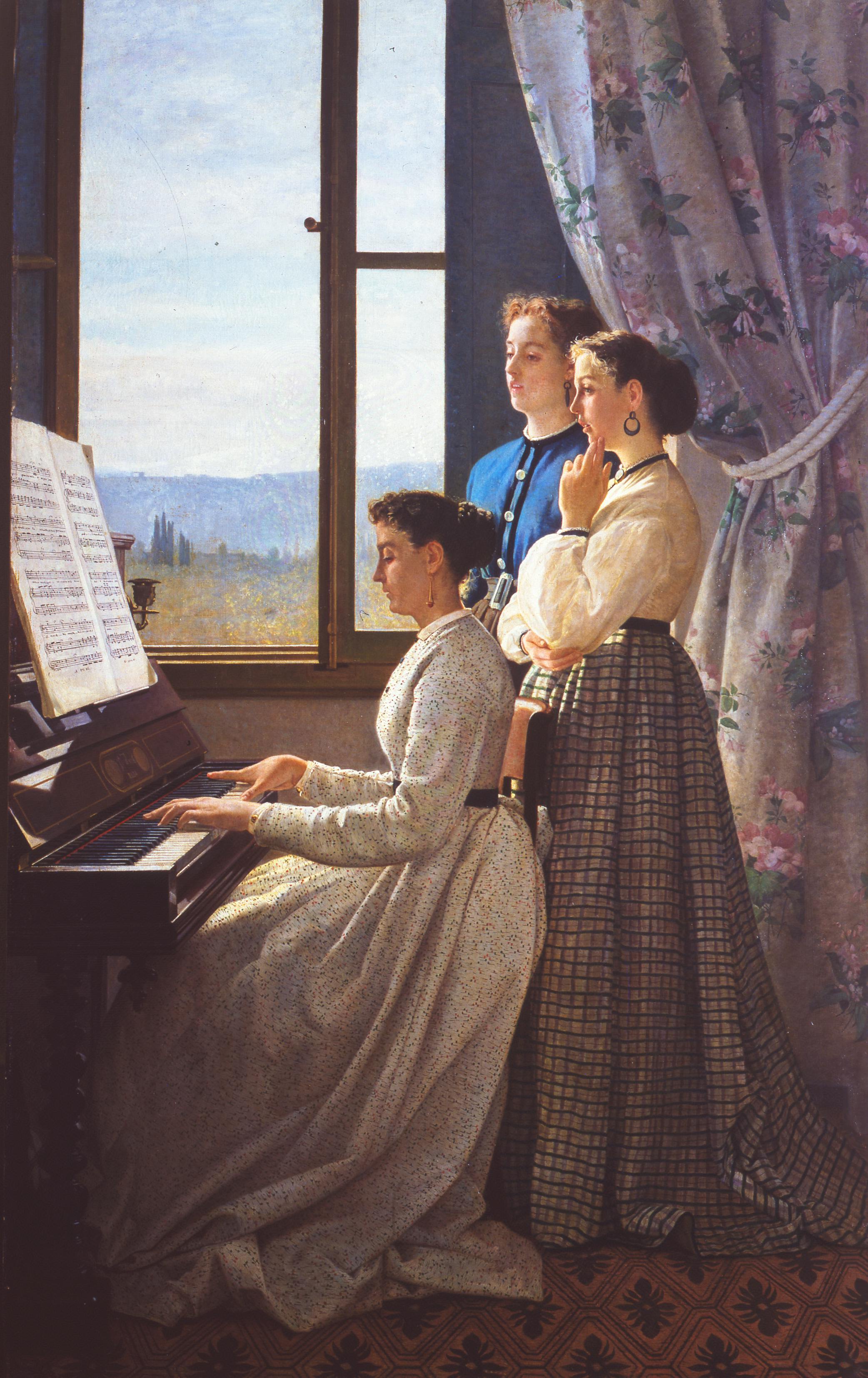Singing a ditty
Silvestro Lega (Modigliana [Forlì] 1826 - Florence 1895)
“S. Lega 67” on the bottom left
Singing a ditty, painted by Silvestro Lega in 1867, is perhaps one of the best-known works by the painter from Romagna and among the most iconic in the Modern Art Gallery of the Pitti Palace.
Three young women on a summer afternoon are enjoying piano music in a country cottage. In the room, skilfully reproduced with almost photographic precision, a window opens onto a landscape characterized by cultivated fields and distant hills, a sort of picture within the picture, from which a soft natural light penetrates to illuminate the interior and exterior in equal measure.
The sharp painting and monumental setting recall 15th century art, in particular Piero della Francesca, whose limpid light allowed him to create volumes and spaces. The recovery of 15th century Tuscan art was a cornerstone of the Macchiaioli painting, of which Silvestro Lega was one of the most original interpreters. The reference to the Tuscan masters of early Renaissance is also evident in the narrative simplicity through which the daily episode is described. The large size of the canvas and the solemnity of the composition turn the painting into a sort of modern altarpiece. Formal perfection and attention to detail also belonged to the teachings of Luigi Mussini and Antonio Ciseri, artists with whom Lega trained at the Accademia di Belle Arti in Florence.
The uniform light defines both characters and setting, composing the scene and at the same time revealing the details of the clothing and the home furnishings, from the sumptuous floral-patterned curtain to the geometrically patterned carpet, allowing even to decipher the notes on the score.
The woman playing the piano is probably the beloved Virginia Batelli, daughter of Spirito Batelli, a Florentine publisher who supported Lega and other artists by hosting them in his family home in Piagentina, a country area just outside the Florentine walls. In these years Florence was the capital and was undergoing profound and painful transformations: the banks of the Arno on the eastern side of the city, under the hills of Fiesole and Settignano, had become the refuge in which Macchiaioli painters could observe and portray the nature of the cultivated fields, the pastimes of the cultured middle class, and the intimacy of domestic affection. The subtle yet serene melancholy transpiring from this painting perfectly portrays that world and that way of feeling, steeped in the disappointment that Macchiaioli painters, who were fervent republican and even anarchist patriots, had to suffer after the Unification of Italy under the Savoy monarchy.
The details of the costumes allow to precisely place the scene in space and time, constituting also a reference to the manual craftsmanship of Renaissance workshops, a tradition tenaciously defended by Lega in opposition to a reality that was inexorably destined to change due to the advance of industrial production.
The painting conveys an almost metaphysical serenity that pervades every corner of the scene and defines the characters themselves, in perfect harmony with one of the most limpid and artistically flourishing periods of Lega's life, during which he painted not only Singing a ditty but also The Pergola (Pinacoteca di Brera, Milan, inv. 2241) and A walk in the garden (Modern Art Gallery of the Pitti Palace, Gen. Cat. 178).
In the musical score, some critics were able to recognise a Ciaccona, a well-known Tuscan folk tune. However, it has been recently hypothesised that it was a piece composed by Luigi Gordigiani, a musician and interpreter of piano music known as 'the Italian Schubert', who was famous above all for his Stornelli (ditties): three hundred melodies for singing and piano which, in the same way as the German Lieder, spread widely also across the border, being appreciated even by Queen Victoria of England. The identification of the piece in question with one of Gordigiani's compositions is based on the particular size of the score placed on the music stand.
L. Lombardi, in I Macchiaioli prima dell’Impressionismo, catalogo della mostra (Padova, 27 settembre 2003-8 febbraio 2004), a cura di F. Mazzocca, C. Sisi, Venezia 2003, pp. 225, 228-229, n. 75; S. Bietoletti, in La Galleria d’Arte Moderna di Palazzo Pitti, Storia e collezioni, a cura di C. Sisi, Cinisello Balsamo, Milano 2005, pp.178-179; Ottocento e Novecento Acquisizioni 1974-1989, catalogo della mostra (Firenze, Galleria d’Arte Moderna di Palazzo Pitti 1 giugno-30 settembre 1989), a cura di C. Sisi, p.58; G. Nardi¸ Una passeggiata musicale nella Galleria d’Arte Moderna. Storia inconsueta di musica, musicisti, vicende, famiglie, in Bollettino. Amici di Palazzo Pitti, 2020, pp. 62-79 (p. 73).
